Current renewables pledges imply that a significant amount of grid storage capacity will be needed globally. However, despite the rapid falls in costs, deploying battery technologies at the scales needed will be costly. At times, lower system costs could be achieved by greater investment in renewable infrastructure, building excess capacity.
Why we need grid storage
Transitioning to fossil-free energy system will require huge growth in low-carbon electricity generation, such as hydro, nuclear, solar and wind energy.
Hydro and nuclear technology are usually large-scale projects requiring long planning and construction periods. Generally, solar and wind technology can be deployed comparatively quickly, with faster return on investment than other low-carbon power sources.
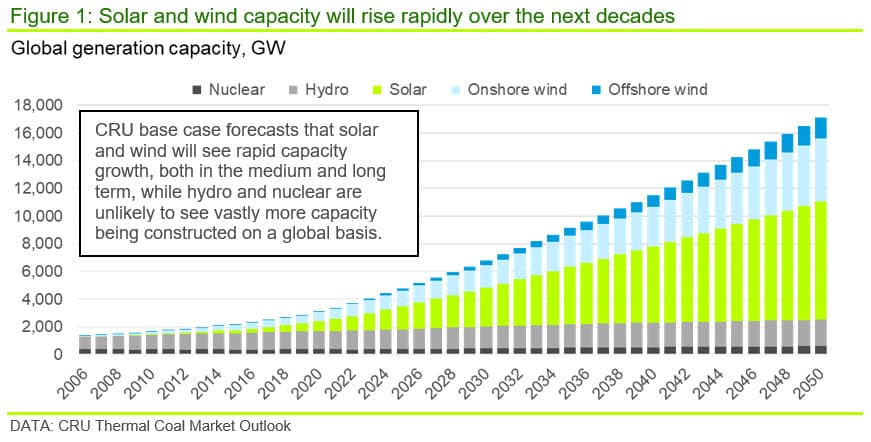
Electricity grids with a high share of solar and wind will experience intermittency, due to daily and seasonal variability of energy supply coupled with demand variability. Periods of imbalance can occur both across a single day, but also across the year, both cause different supply/demand rectification challenges.
There are various approaches for dealing with this intermittency, including demand-side management, oversizing power supply allowing flexibility to cover demand under all conditions, or using energy storage systems to ‘shift’ power from periods of supply excess to periods of deficit.
Intermittency will need to be addressed
For the purposes of the cost analysis below, we have modelled a scenario where regions follow an ordinary transition, hit their pledges, where the electricity grid becomes highly decarbonised and where nuclear and hydro energy take only a small role dealing with the intermittency problems. We have modelled costs for systems where excessive building of renewable infrastructure together with the mass deployment of energy storage is needed.
In this analysis, we seek to find the optimum cost solution between required storage capacity and overbuilding renewables to minimise the occurrence of supply deficits – and here we assume a mix of solar and wind. Thus, this optimisation is driven by the relative cost of storage capacity versus that of renewables capacity.
Energy storage technologies include electrochemical battery energy storage system (BESS), mechanical (i.e., pumped hydro, compressed air, etc.), thermal, etc. BESS are set to see huge growth and much of this will be lithium-ion phosphate (LFP) batteries, which are safe and lower cost.
It should be noted that our optimisation assumes full interconnectivity between all generation and demand centres. However, the costs of achieving this interconnectivity are not assessed and will add to any costs quoted here. Equally, failure to achieve full connectivity will lead to lower flexibility and, ultimately, higher costs than those quoted.
Huge growth in renewable capacity will result in high storage costs
CRU believes that grid storage has been underrepresented in decarbonisation plans and that renewable capacity targets will need to be higher to economically enable full decarbonisation of grids.
To demonstrate this, we have modelled Europe’s electricity generation profile in 2030 based on the REPowerEU Plan updated in December 2022, which targets 1,236 GW of renewable capacity in 2030. We have then overlayed CRU’s forecasts for electricity demand and the battery storage capacity this requires, shown in Figure 2.
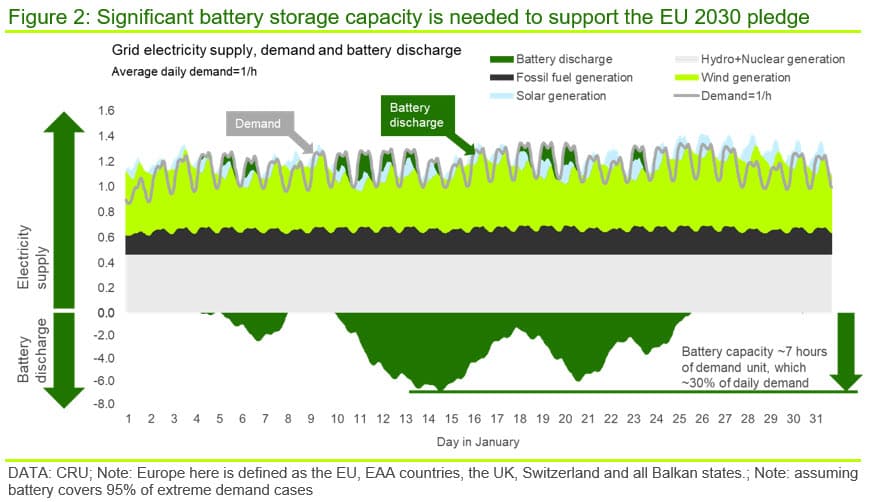
The results from this suggest that Europe is already considering a degree of excess capacity in the targets: in 2030, non-renewables could supply 63% of grid demand, while renewables could generate electricity equal to 70% of total demand. This means ~33% of excess capacity will need to be curtailed or used for purposes other than on the grid.
Even with the overbuild of capacity, our analysis shows that battery storage will still be needed due to the intermittent nature of renewables. Applying historical trends on demand patterns and considering non-renewable power as base load power, our model shows grid storage will need to be as high as 30% of daily total electricity demand in Europe. Assuming there are flexible fossil fuel powered plants to deal with the top 10% percentile extreme supply/demand deficit events, Europe will still need ~195 GW of storage in 2030, equivalent of 6% of daily demand, whereas total storage capacity in Europe currently is closer to ~60 GW (n.b. mainly pumped hydro).
This required level of storage will lift the weighted levelised cost of renewables from ~$68 /MW to ~$104 /MWh in real terms in 2030. A carbon price of at least ~$150 /tCO2 in 2030 would be required to make renewable power cost competitive with natural gas power in this scenario.
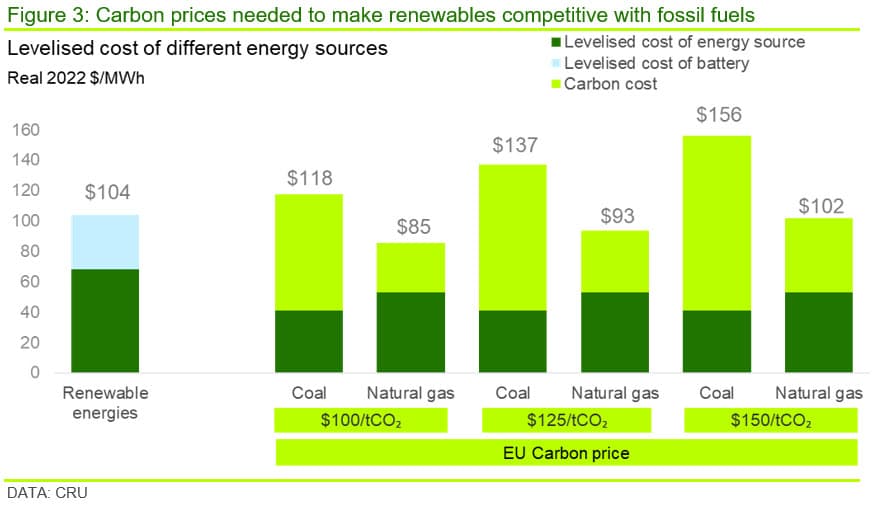
The above result is based on current announced targets for renewable deployment in the EU. However, we believe a more optimal – or lower cost – solution could be available with further oversizing of renewable supply (i.e. removing renewable capacity as a constraint). Below, we apply our analysis to the European situation to identify the lowest cost solution and, further on, apply the same methodology to other countries for a broader comparison.
More oversizing of renewables will be the solution
Europe could reduce storage costs by further increasing capacity targets for solar and wind installations, as illustrated in Figure 4.
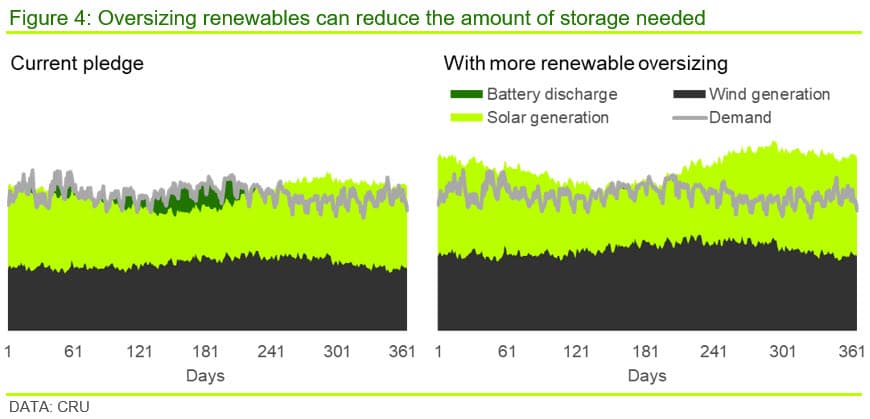
For Europe, our analysis shows that adding 6% more renewable generation to the grid will reduce the requirements of battery storage to 17 GW, equivalent 0.5% of daily output, and thus reduce the levelised cost of renewables plus battery storage by ~$40 /MWh in 2030, 38% compared to the current pledge scenario.
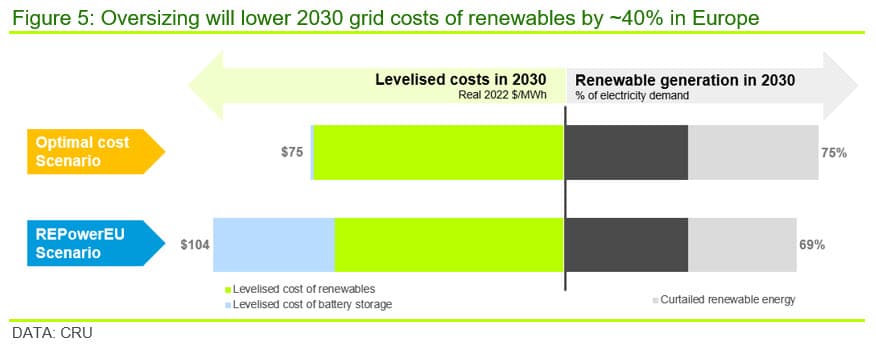
Applying this approach to other regions, given that Europe has one of the most ambitious targets for renewables installation serving the grid, it is clear that the impact on costs of necessary storage is going to be greater elsewhere.
The US climate can exhibit a high degree of variability throughout the year (e.g., extreme cold events are relatively frequent), thus, electricity demand is relatively volatile. This suggests that the storage requirements to meet these large swings in demand will be high and costly. However, the cost could be reduced by oversizing the renewables capacity base. Japan has naturally low load factors for solar and wind resources and therefore also requires a higher capacity of renewables to reduce the cost of storage.
The chart below shows that the levelised cost of renewables and battery storage in several regions (LHS) will be reduced compared to their original pledges with more overbuilding of renewables (RHS).
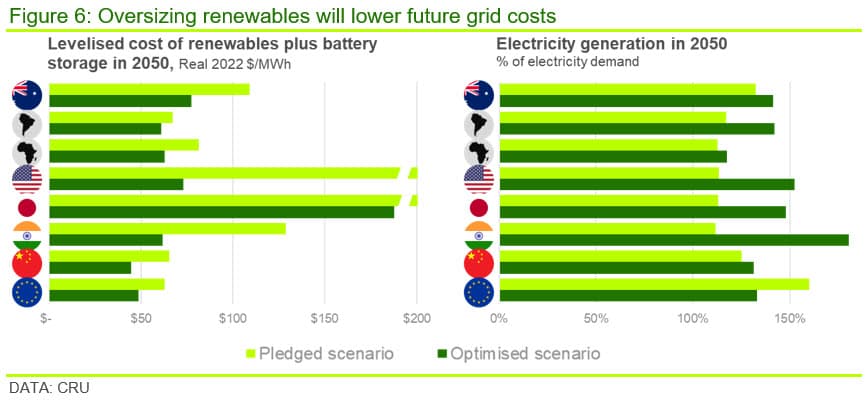
At first glance, this may seem wasteful, as a significant proportion of the power produced by renewable installations appears to go unused. However, we believe a significant proportion of this ‘excess’ power could be used elsewhere, for example to produce hydrogen using electrolysers flexibly.
This could create two pricing points for the electricity produced: a higher price for continuous power supplied to the grid for current grid connected uses and a lower price for variable power supplied to hydrogen production. In the above chart, we have not credited this excess power, but this will lower the quoted costs and we will explore these differentiated price points in future insights.
Building even more renewables could lower levelised costs
Storage will be increasingly important to energy grids as the proportion of renewable power in the generation mix grows. However, we do not think the scope of the challenge and costs of intermittency of supply have yet been fully digested by policy makers.
Current long-term pledges imply very high levels of installed grid storage capacity will be needed to balance the mismatches between electricity supply and demand, but this will be costly. A lower cost solution can be achieved by overbuilding renewables to a greater extent than currently implied, but this increases the challenge of building out significant renewable capacity. We believe grid operators and policy makers have yet to fully factor in these competing challenges.
Find out more about our Sustainability Services.
Our reputation as an independent and impartial authority means you can rely on our data and insights to answer your big sustainability questions.
Tell me more


